Changes in Anticipatory VtoV Coarticulation in French during Adulthood
Abstract
1. Introduction
2. Materials and Methods
2.1. Participants
2.2. Speech Material and Acoustic Analysis
2.3. Statistical Analysis
3. Results
3.1. Relationship between Speech Rate and Age
3.2. Relationship between Coarticulation, Age and Speech Rate
4. Discussion
Author Contributions
Funding
Institutional Review Board Statement
Informed Consent Statement
Acknowledgments
Conflicts of Interest
Appendix A
Speech Material
- Melanie vend du lilas
- Lundi, le chat, le loup et Papa vont à Bali. Les copains sont tout contents. Mardi, Papi y va aussi. Il dit: “Je n’ai pas un sou! Qui va prendre soin de moi?” “ Moi!” dit le chat, “moi!” dit le loup. “Vous?”, Papi réfléchit. Mercredi, Papi dit: “Toi, le chat, tu es doux, tu es chou, tu n’as pas de poux! Mais pas ce loup: il a une cape rouge et je n’aime pas ce gars-là!”. Jeudi, le chat et Papi se baladent à Bali. Papa glisse! Aïe! Ouille! Son cou craque, son coude claque, c’est la débâcle!. Vendredi, Papa a mal. Il pleure, il crie! “Toi, Papi, aide-moi, trouve le nain!” “Un nain? On n’en a jamais vu par ici?!”. Samedi matin, le chat va voir son ami le loup et lui dit: “Aide-moi à soigner Papa!”. Samedi soir, le loup lui donne sa recette magique: “Coupe un oignon, cache-le sous la souche, et lorsque le lilas fleurira, Papa sera guéri!” Abracadabra, ça y est, on a réussi!. Dimanche, le chat tout doux, le loup magicien, Papa et Papi quittent Bali. Les copains sont tout contents.
References
- Agwuele, Augustine, Harvey M. Sussman, and Bjorn Lindblom. 2008. The effect of speaking rate on consonant vowel coarticulation. Phonetica 654: 194–209. [Google Scholar] [CrossRef]
- Albuquerque, Luciana, Catarina Oliveira, António Teixeira, Predo Sa-Couto, and Daniela Figueiredo. 2019. Age-related changes in European Portuguese vowel acoustics. Paper present at Interspeech, Graz, Austria, September 15–19; pp. 3965–69. [Google Scholar] [CrossRef]
- Albuquerque, Luciana, Catarina Oliveira, António Teixeira, Predo Sa-Couto, and Daniela Figueiredo. 2020. A comprehensive analysis of age and gender effects in European Portuguese oral vowels. Journal of Voice. [Google Scholar] [CrossRef]
- Barbier, Guillaume, Pascal Perrier, Yohan Payan, Mark K. Tiede, Sylvain Gerber, Joe S. Perkell, and Lucie Ménard. 2020. What anticipatory coarticulation in children tells us about speech motor control maturity. PLoS ONE 154: e0231484. [Google Scholar] [CrossRef]
- Berry, Jeff. 2011. Speaking rate effects on normal aspects of articulation: Outcomes and issues. Perspectives on Speech Science and Orofacial Disorders 21: 15–26. [Google Scholar] [CrossRef]
- Bilodeau-Mercure, Mylène, Vanessa Kirouac, Nancy Langlois, Claudie Ouellet, Isabelle Gasse, and Pascale Tremblay. 2015. Movement sequencing in normal aging: Speech, oro-facial, and finger movements. Age 374: 1–13. [Google Scholar] [CrossRef] [PubMed]
- Boehmke, Brad, and Brandon M. Greenwell. 2019. Hands-On Machine Learning with R. Boca Raton: Taylor and Francis and CRC Press. ISBN 9781138495685. [Google Scholar]
- Boersma, Paul, and David Weenink. 2021. Praat: Doing Phonetics by Computer [Computer Program]. Version 6.1.50. Available online: http://www.praat.org/ (accessed on 20 June 2021).
- Bourbon, Angelina, and Anne Hermes. 2020. Have a break: Aging effects on sentence production and structuring in French. Paper present at the 12th International Seminar on Speech Production, Virtual. December 14–18; New Haven: Haskins Press. ISBN 978-1-7360794-2-3. [Google Scholar]
- Browman, Cathy, and Louis Goldstein. 1990. Tiers in Articulatory Phonology, with Some Implications for Casual Speech. Cambridge: Cambridge University Press, pp. 341–76. [Google Scholar] [CrossRef]
- Browman, Cathy, and Louis Goldstein. 1992. Articulatory phonology: An overview. Phonetica 49: 155–80. [Google Scholar] [CrossRef] [PubMed]
- Byrd, Dani, and Cheng-Cheng Tan. 1996. Saying consonant clusters quickly. Journal of Phonetics 24: 263–82. [Google Scholar] [CrossRef]
- Caçola, Priscila, Jerroed Roberson, and Carl Gabbard. 2013. Aging in movement representations for sequential finger movements: A comparison between young-, middle-aged, and older adults. Brain and Cognition 821: 1–5. [Google Scholar] [CrossRef]
- Cooke, J. David, Susan H. Brown, and David A. Cunningham. 1989. Kinematics of arm movements in elderly humans. Neurobiology of Aging 102: 159–65. [Google Scholar] [CrossRef]
- D’Alessandro, Daria, Angelina Bourbon, and Cécile Fougeron. 2020. Effect of age on rate and coarticulation across different speech-tasks. Paper present at the 12th International Seminar on Speech Production, Virtual. December 14–18; New Haven: Haskins Press. ISBN 978-1-7360794-2-3. [Google Scholar]
- D’Alessandro, Daria, and Cécile Fougeron. 2018. Réduction de la coarticulation et vieillissement. Paper present at the XXXIIe Journées d’Études sur la Parole, Aix-en-Provence, France, June 4–8; pp. 410–18. [Google Scholar] [CrossRef]
- Duez, Danielle. 1992. Second formant locus-nucleus patterns: An investigation of spontaneous French speech. Speech Communication 11: 417–27. [Google Scholar] [CrossRef]
- Eichhorn, Julie T., Raymond D. Kent, Diane Austin, and Houri K. Vorperian. 2018. Effects of aging on vocal fundamental frequency and vowel formants in men and women. Journal of Voice 325: 644.e1–e9. [Google Scholar] [CrossRef] [PubMed]
- Engstrand, Olle. 1988. Articulatory correlates of stress and speaking rate in Swedish VCV utterances. The Journal of the Acoustical Society of America 83: 1863–75. [Google Scholar] [CrossRef]
- Fletcher, Annalise R., Megan J. McAuliffe, Kaitlin L. Lansford, and Julie M. Liss. 2015. The relationship between speech segment duration and vowel centralization in a group of older speakers. The Journal of the Acoustical Society of America 1384: 2132–39. [Google Scholar] [CrossRef]
- Fougeron, Cécile, Fanny Guitard-Ivent, and Véronique Delvaux. 2021. Multi-Dimensional Variation in Adult Speech as a Function of Age. Languages 6: 176. [Google Scholar] [CrossRef]
- Friedman, Jérome H. 1991. Multivariate adaptive regression splines. The Annals of Statistics 19: 1–67. [Google Scholar] [CrossRef]
- Gahl, Susanne, and R. Harald Baayen. 2019. Twenty-eight years of vowels: Tracking phonetic variation through young to middle age adulthood. Journal of Phonetics 74: 42–54. [Google Scholar] [CrossRef]
- Gay, Thomas. 1981. Mechanisms in the control of speech rate. Phonetica 381: 148–58. [Google Scholar] [CrossRef] [PubMed]
- Goozée, Justine V., Leonard L. Lapointe, and Bruce E. Murdoch. 2003. Effects of speaking rate on EMA-derived lingual kinematics: A preliminary investigation. Clinical Linguistics & Phonetics 17: 375–81. [Google Scholar] [CrossRef]
- Hardcastle, William J. 1985. Some phonetic and syntactic constraints on lingual coarticulation during/kl/sequences. Speech Communication 41: 247–63. [Google Scholar] [CrossRef]
- Hermes, Anne, Jane Mertens, and Doris Mücke. 2018. Age-related Effects on Sensorimotor Control of Speech Production. Paper present at INTERSPEECH, Hyderabad, India, September 2–6; pp. 1526–30. [Google Scholar] [CrossRef]
- Hertrich, Ingo, and Hermann Ackermann. 1995. Coarticulation in slow speech: Durational and spectral analysis. Language and Speech 382: 159–87. [Google Scholar] [CrossRef] [PubMed]
- Hirai, Toshihiro, Osamu Tanaka, Hisashi Koshino, and Toshihiko Yajima. 1991. Ultrasound observations of tongue motor behavior. The Journal of Prosthetic Dentistry 656: 840–44. [Google Scholar] [CrossRef]
- Horton, William S., Daniel H. Spieler, and Elizabeth Shriberg. 2010. A corpus analysis of patterns of age related change in conversational speech. Psychology and Aging 25: 708. [Google Scholar] [CrossRef]
- Jacewicz, Ewa, Robert A. Fox, Caitlin ONeill ’, and Joseph Salmons. 2009. Articulation rate across dialect, age, and gender. Language Variation and Change 21: 233–56. [Google Scholar] [CrossRef] [PubMed]
- Jacewicz, Ewa, Robert A. Fox, and Lai Wei. 2010. Between-speaker and within-speaker variation in speech tempo of American English. The Journal of the Acoustical Society of America 1282: 839–50. [Google Scholar] [CrossRef]
- Ketcham, Caroline J., and George E. Stelmach. 2004. Movement control in the older adult. In Technology for Adaptive Aging. Washington, DC: National Academies Press US. Available online: https://www.ncbi.nlm.nih.gov/books/NBK97342/ (accessed on 27 September 2021).
- Kühnert, Barbara, and Francis Nolan. 1999. The origin of coarticulation. In Coarticulation: Theory, Data and Techniques. Edited by W. Hardcastle and N. Hewlett. Cambridge: Cambridge University Press, pp. 7–30. [Google Scholar] [CrossRef]
- Laganaro, Marina, Cécile Fougeron, Michaela Pernon, Nathalie Levêque, Stéphanie Borel, Maryll Fournet, Sabina Catalano Chiuvé, Ursula Lopez, Roland Trouville, Lucie Ménard, and et al. 2021. Sensitivity and specificity of an acoustic- and perceptual-based tool for assessing motor speech disorders in French: The MonPaGe-screening protocol. Clinical Linguistics & Phonetics 35: 1–16. [Google Scholar] [CrossRef]
- Liss, Julie M., Garry Weismer, and John C. Rosenbek. 1990. Selected acoustic characteristics of speech production in very old males. Journal of Gerontology 45: 35–45. [Google Scholar] [CrossRef]
- Ma, Liang, Pascal Perrier, and Jianwu Dang. 2015. Strength of syllabic influences on articulation in Mandarin Chinese and French: Insights from a motor control approach. Journal of Phonetics 53: 101–24. [Google Scholar] [CrossRef]
- Manuel, Sharon. 1999. Cross-language studies: Relating language-particular coarticulation patterns to other language-particular facts. In Coarticulation: Theory, Data and Techniques. Edited by W. Hardcastle and N. Hewlett. Cambridge: Cambridge University Press. [Google Scholar] [CrossRef]
- Matthies, Melanie, Pascal Perrier, Joseph S. Perkell, and Majid Zandipour. 2001. Variation in anticipatory coarticulation with changes in clarity and rate. J Journal of Speech, Language, and Hearing Research 44: 340–53. [Google Scholar] [CrossRef]
- Milborrow, Stephen. 2021. Earth: Multivariate Adaptive Regression Splines. R Package Version 5.3.1. Available online: https://cran.r-project.org/web/packages/earth/index.html (accessed on 20 October 2021).
- Mok, Peggy P. K. 2012. Effects of consonant cluster syllabification on vowel-to-vowel coarticulation in English. Speech Communication 54: 946–56. [Google Scholar] [CrossRef]
- Mücke, Doris, Anne Hermes, and Sam Tilsen. 2020. Incongruencies between phonological theory and phonetic measurement. Phonology 37: 133–70. [Google Scholar] [CrossRef]
- Mücke, Doris, Tabea Thies, Jane Mertens, and Anne Hermes. 2021. Age-related effects of prosodic prominence in vowel articulation. Paper present at the 12th International Seminar on Speech Production, Virtual. December 14–18; New Haven: Haskins Press. ISBN 978-1-7360794-2-3. [Google Scholar]
- Nijland, Lian, Ben Maassen, Sjoeke Van der Meulen, Fons Gabreëls, Floris W. Kraaimaat, and Rob Schreuder. 2002. Coarticulation patterns in children with developmental apraxia of speech. Clinical Linguistics & Phonetics 166: 461–83. [Google Scholar] [CrossRef]
- Nittrouer, Susan, Michael Studdert-Kennedy, and Stephen T. Neely. 1996. How children learn to organize their speech gestures: Further evidence from fricative-vowel syllables. Journal of Speech, Language, and Hearing Research 392: 379–89. [Google Scholar] [CrossRef]
- Noiray, Aude, Martijn Wieling, Dzhuma Abakarova, Elina Rubertus, and Mark Tiede. 2019. Back from the future: Nonlinear anticipation in adults’ and children’s speech. Journal of Speech, Language, and Hearing Research 628S: 3033–54. [Google Scholar] [CrossRef]
- Pernon, Michaela, Nathalie Levêque, Véronique Delvaux, Fréderic Assal, Stéphanie Borel, Cécile Fougeron, Roland Trouville, and Marina Laganaro. 2020. MonPaGe, un outil de screening francophone informatise d’évaluation perceptive et acoustique des troubles moteurs de la parole (dysarthries, apraxie de la parole). Rééducation Orthophonique 281: 171–97. [Google Scholar]
- Pohl, Patricia S., Carolee J. Winstein, and Beth E. Fisher. 1996. The locus of age-related movement slowing: Sensory processing in continuous goal-directed aiming. The Journals of Gerontology Series B: Psychological Sciences and Social Sciences 512: P94–P102. [Google Scholar] [CrossRef] [PubMed]
- R Core Development Team. 2021. R: A Language and Environment for Statistical Computing. Vienna: R Foundation for Statistical Computing. Available online: https://www.R-project.org/ (accessed on 16 October 2021).
- Ramig, Lorraine A. 1983. Effects of physiological aging on speaking and reading rates. Journal of Communication Disorders 163: 217–26. [Google Scholar] [CrossRef]
- Recasens, Daniel. 2015. The effect of stress and speech rate on vowel coarticulation in catalan vowel–consonant–vowel sequences. Journal of Speech, Language, and Hearing Research 585: 1407–24. [Google Scholar] [CrossRef]
- Recasens, Daniel. 2018. Coarticulation. Oxford Research Encyclopedia of Linguistics. Available online: https://oxfordre.com/linguistics/view/10.1093/acrefore/9780199384655.001.0001/acrefore-9780199384655-e-416 (accessed on 25 October 2021).
- Rosenblum, Sara, Batya Engel-Yeger, and Yael Fogel. 2013. Age-related changes in executive control and their relationships with activity performance in handwriting. Human Movement Science 322: 363–76. [Google Scholar] [CrossRef]
- Scarborough, Rebecca, and Georgia Zellou. 2013. Clarity in communication: “Clear” speech authenticity and lexical neighborhood density effects in speech production and perception. The Journal of the Acoustical Society of America 134: 3793–807. [Google Scholar] [CrossRef] [PubMed]
- Tillmann, Hans G., and Harmut R. Pfitzinger. 2003. Local speech rate: Relationships between articulation and speech acoustics. Paper presented at ICPhS-15, Barcelona, Spain, August 3–9; pp. 3177–80. [Google Scholar]
- Tjaden, Kris, and Gregory E. Wilding. 2005. Effect of rate reduction and increased loudness on acoustic measures of anticipatory coarticulation in multiple sclerosis and Parkinson’s disease. Journal of Speech, Language, and Hearing Research 48: 261–77. [Google Scholar] [CrossRef]
- Traunmüller, Hartmut. 1990. Analytical expressions for the tonotopic sensory scale. The Journal of the Acoustical Society of America 88: 97–100. [Google Scholar] [CrossRef]
- Van Son, Rob J. J. H., and Luis C. W. Pols. 1992. Formant movements of Dutch vowels in a text, read at normal and fast rate. The Journal of the Acoustical Society of America 921: 121–27. [Google Scholar] [CrossRef]
- Whalen, Doug H. 1990. Coarticulation is largely planned. Journal of Phonetics 18: 3–35. [Google Scholar] [CrossRef]
- Zharkova, Natalia. 2017. Voiceless alveolar stop coarticulation in typically developing 5-year-olds and 13-year-olds. Clinical Linguistics & Phonetics 317: 503–13. [Google Scholar] [CrossRef]
- Zharkova, Natalia, Nigel Hewlett, and William J. Hardcastle. 2012. An ultrasound study of lingual coarticulation in/sV/syllables produced by adults and typically developing children. Journal of the International Phonetic Association 422: 193–208. [Google Scholar] [CrossRef]
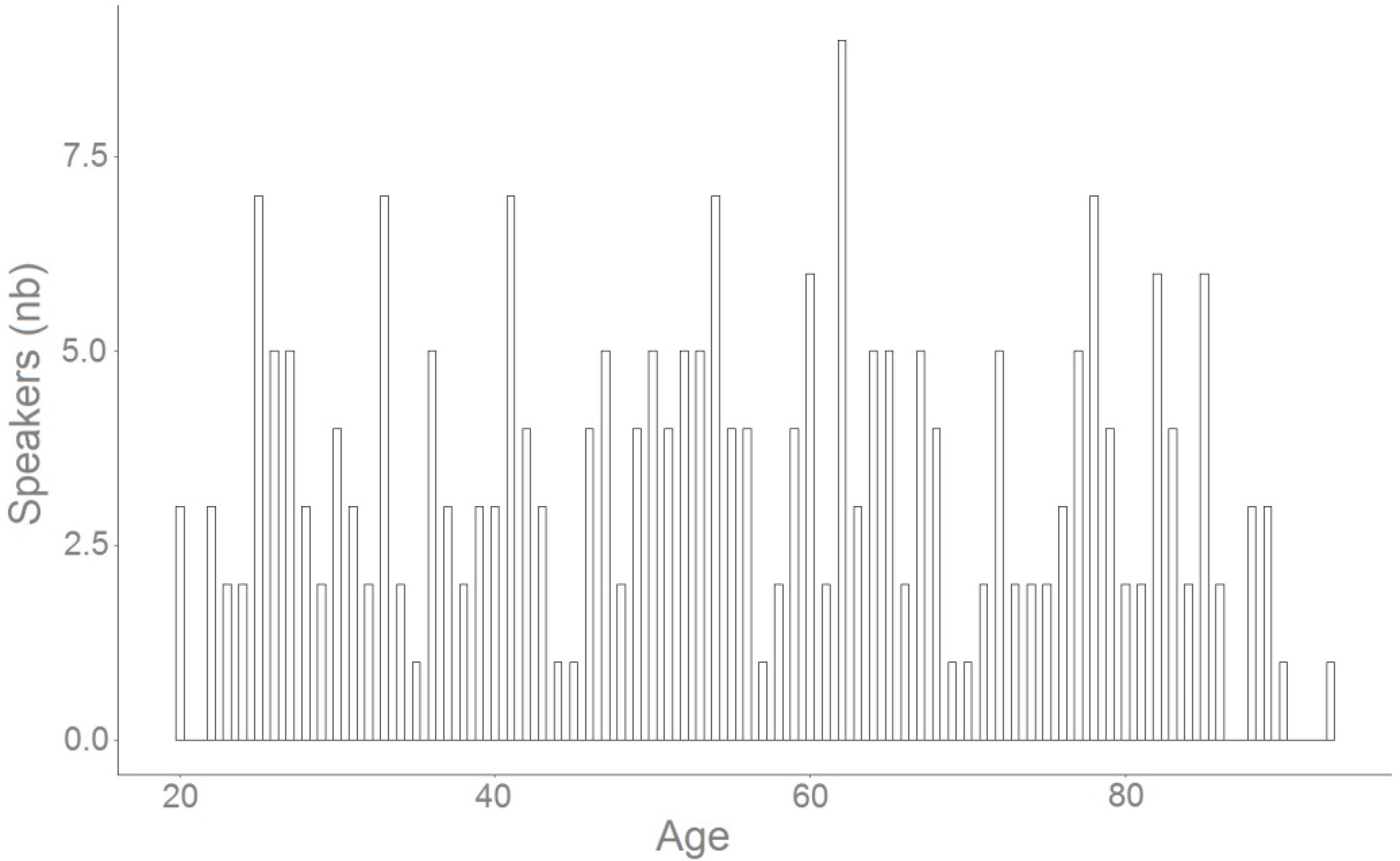

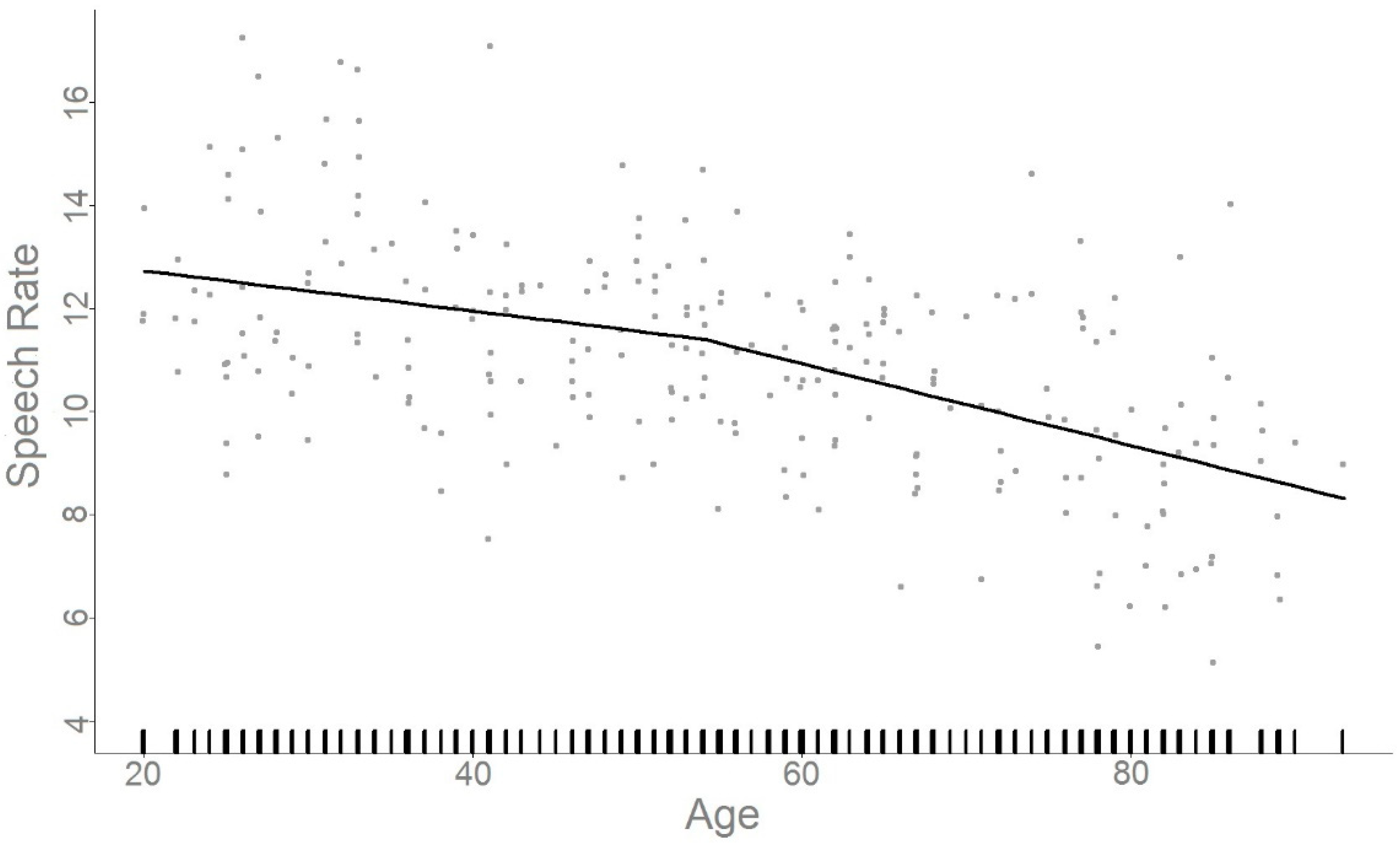
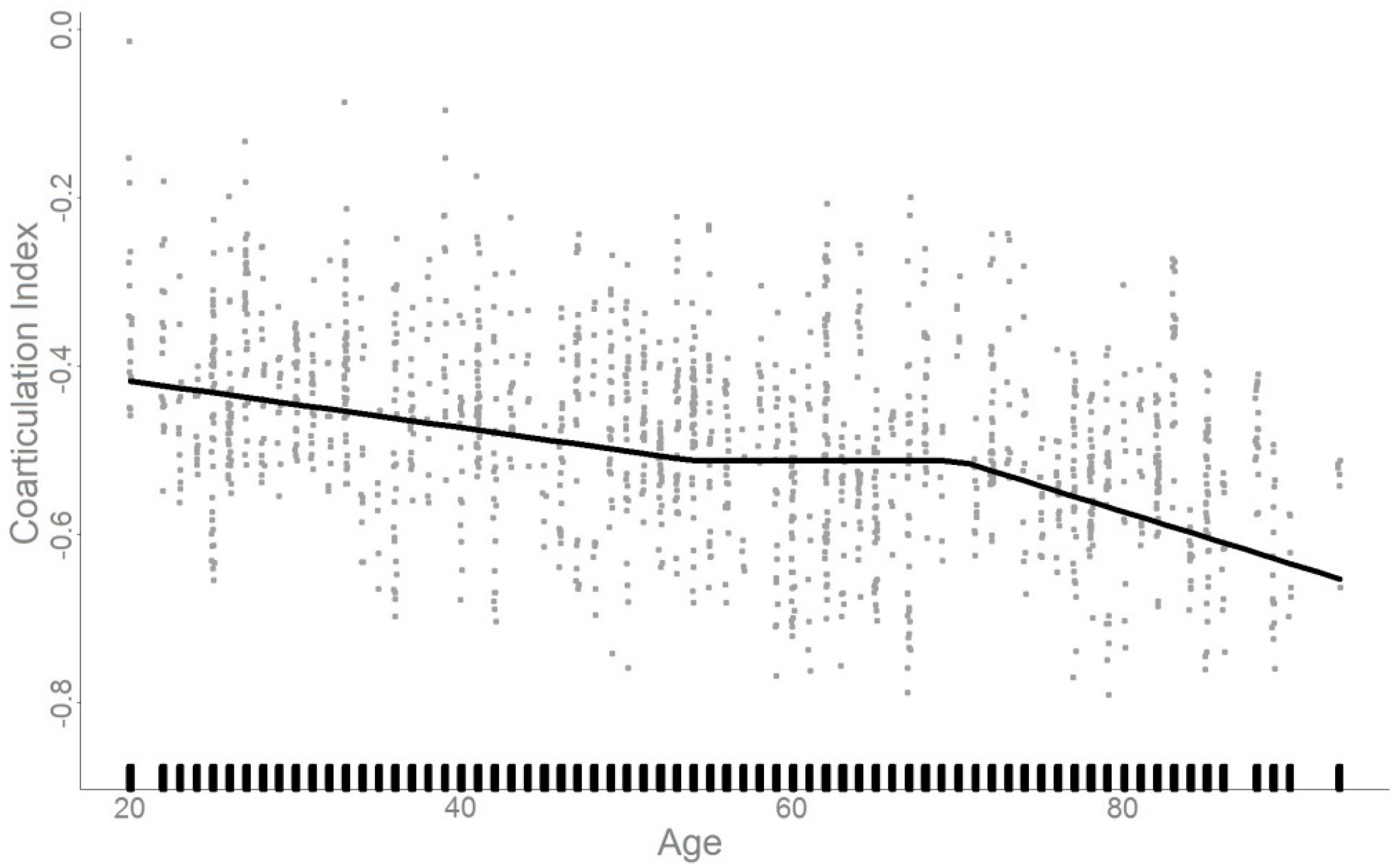
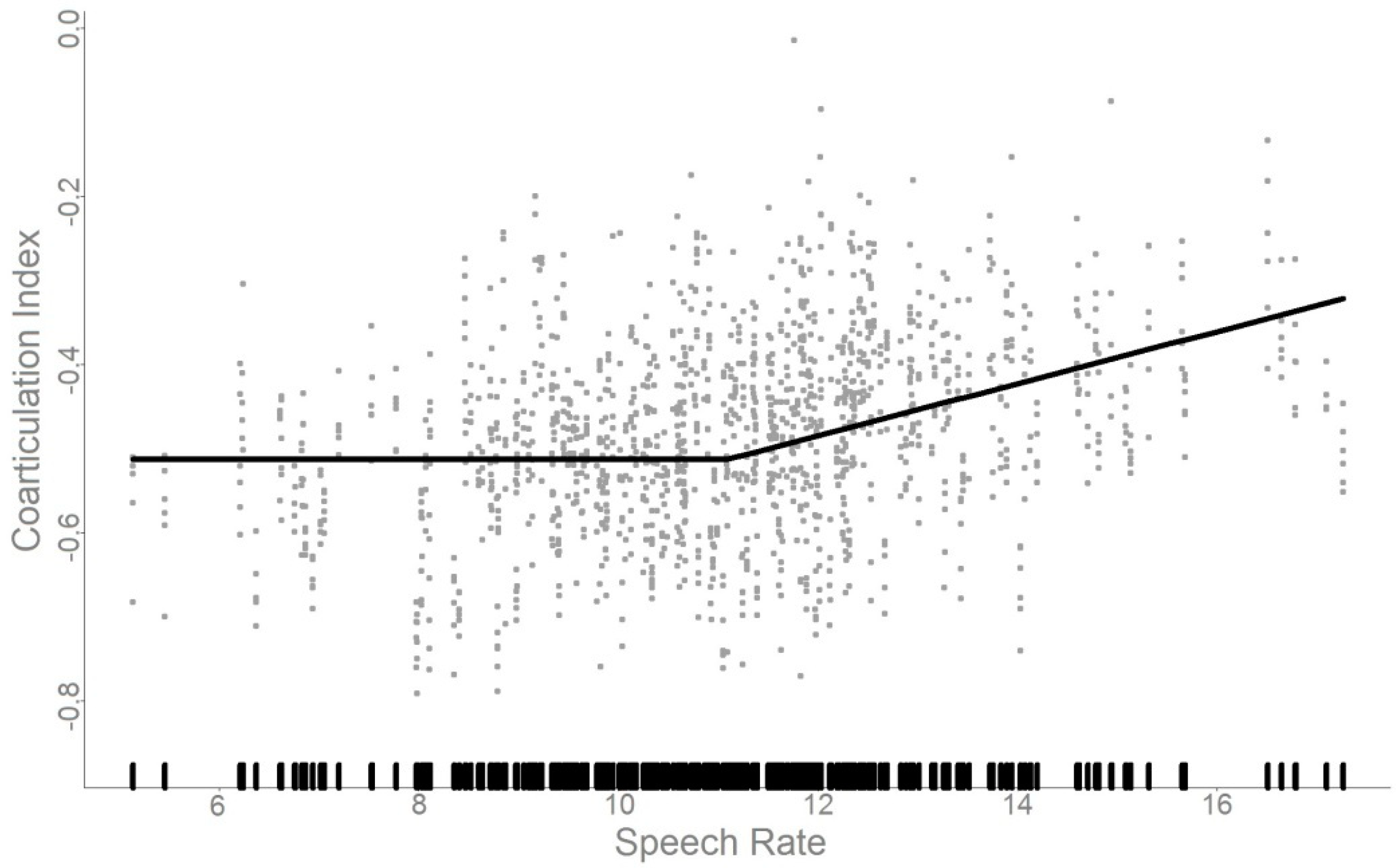
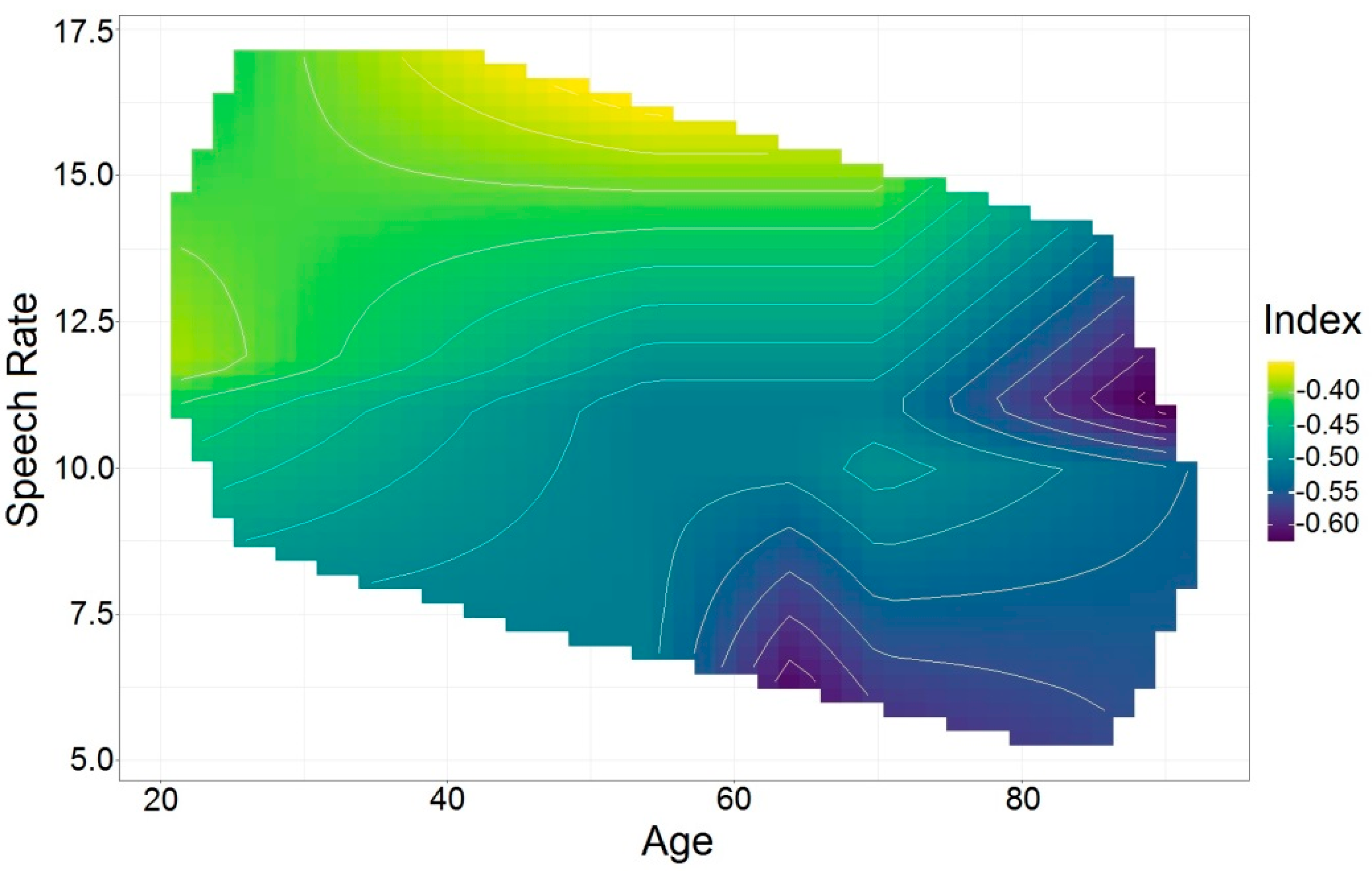
Publisher’s Note: MDPI stays neutral with regard to jurisdictional claims in published maps and institutional affiliations. |
© 2021 by the authors. Licensee MDPI, Basel, Switzerland. This article is an open access article distributed under the terms and conditions of the Creative Commons Attribution (CC BY) license (https://creativecommons.org/licenses/by/4.0/).
Share and Cite
D’Alessandro, D.; Fougeron, C. Changes in Anticipatory VtoV Coarticulation in French during Adulthood. Languages 2021, 6, 181. https://doi.org/10.3390/languages6040181
D’Alessandro D, Fougeron C. Changes in Anticipatory VtoV Coarticulation in French during Adulthood. Languages. 2021; 6(4):181. https://doi.org/10.3390/languages6040181
Chicago/Turabian StyleD’Alessandro, Daria, and Cécile Fougeron. 2021. "Changes in Anticipatory VtoV Coarticulation in French during Adulthood" Languages 6, no. 4: 181. https://doi.org/10.3390/languages6040181
APA StyleD’Alessandro, D., & Fougeron, C. (2021). Changes in Anticipatory VtoV Coarticulation in French during Adulthood. Languages, 6(4), 181. https://doi.org/10.3390/languages6040181




